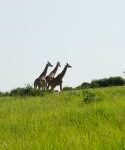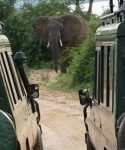May 12, 2018
Being Nile High
As I warned, we are in de Nile, or rather in sight of de Nile, the Victoria Nile (one of the major branches) at Murchison Falls National Park, at  2400 square miles, the largest preserve in Uganda.
2400 square miles, the largest preserve in Uganda.
It wasn’t always so.
Though it was originally set up in 1910, its checkered history included a staging ground as part of the civil wars (it’s close to the border with Congo), at which time many of the animals were slaughtered. The park has rebuilt populations, partly with imports from other countries, mostly Kenya, and culled a rampant and destructive elephant herd. Currently, it has large numbers of giraffes, elephants, monkeys (we have a resident baboon on the hotel grounds who scatters when he sees the maintenance people, but boldly steals from guests; she—it’s a whole baboon family including a really photogenic baby—pilfered a bagged lunch from a table and proceeded to rip it open and devour the food) and other members of what I call the vegetarians—lovers of the grassland and the trees that dot the open savannah. Perhaps the most pronounced feature of the savannah is the sense of space, the expanse stretching as far as the eye can see.
This morning was a “game drive,” starting at 6:15 and lasting until around 10 o’clock that had us over hill and dale, in Land Cruisers (we had  to stay on the road) peering into the distance—or up close—for the kobs and Jackson’s hartebeest, water buffalos of various varieties, the elephants, hyenas, and jackals that make the park home. One group spotted a baby leopard, but as I said, we saw mostly the vegetarians, peacefully but warily coexisting. The evening was better since it was partly along the Nile, and the giraffes and elephants in particular came for a drink (the local beer is, naturally, Nile, and as someone quipped, “It’s Nile time.”) It was a little scary driving back in the dark over bumpy roads in an open Land Cruiser.
to stay on the road) peering into the distance—or up close—for the kobs and Jackson’s hartebeest, water buffalos of various varieties, the elephants, hyenas, and jackals that make the park home. One group spotted a baby leopard, but as I said, we saw mostly the vegetarians, peacefully but warily coexisting. The evening was better since it was partly along the Nile, and the giraffes and elephants in particular came for a drink (the local beer is, naturally, Nile, and as someone quipped, “It’s Nile time.”) It was a little scary driving back in the dark over bumpy roads in an open Land Cruiser.


This was my eighth or so game drive, and as I remarked to Mike Shealy, the logistic director of the trip, it never gets old; more than that, it’s a real high (at least a Nile high?)—watching giraffes munching on leaves, then walking left right left (both right legs move then both left legs move), or watching the semi-predators, the hyenas and jackals, circle and await an opportunity to strike.
To get here (and stay in a lodge that gets high marks for “bush” architecture), it took us almost 8 hours to traverse the 150 miles. That’s as the crow flies, though, and we were driving. About an hour of that was getting out of the sprawling city of Kampala (though it did take us thorough the delightful embassy area), and part of it was waiting for the ferry to cross the Nile. The last 45 miles or so was on dirt roads, which verified what we’d been told in Kampala—Uganda has infrastructure problems, particularly in the North.
On the way, we drove through a lot of small towns; only 10% of the population lives in the Kampala-Entebbe corridor. Interestingly enough, many of them had mosques or madrassas; one of the South Carolina faculty told me he was researching the increasing Arabic financing in Africa—Abu Dhabi airfare is under $300 from here.
Second, we saw agriculture that was mostly manual—I saw only two tractors, and one Cat grader—and no horses or cows, though our driver said that in the planting season, cows pull plows. The crops were mostly bananas, and, evoking nostalgia, corn.
Third, we stopped at a white rhinoceros sanctuary. The rhinos were exterminated from Uganda during the wars, No doubt poaching played a role; rhino horns are in great demand in Asia as an aphrodisiac. I’ve been told ground rhino horn costs three times as much as gold.

 Rhinos fared better here because interested citizens formed an NGO to reestablish their presence. Around 2004, they got one from Kenya and one from the United States; their child, the first of what is now a “crash” (take a crash course and look it up in the dictionary) of 22, was named “Obama.” The goal is to have around 40 so they can release them to the parks.
Rhinos fared better here because interested citizens formed an NGO to reestablish their presence. Around 2004, they got one from Kenya and one from the United States; their child, the first of what is now a “crash” (take a crash course and look it up in the dictionary) of 22, was named “Obama.” The goal is to have around 40 so they can release them to the parks.
During the civil war, both people and animals suffered; from what we have seen, both are recovering.